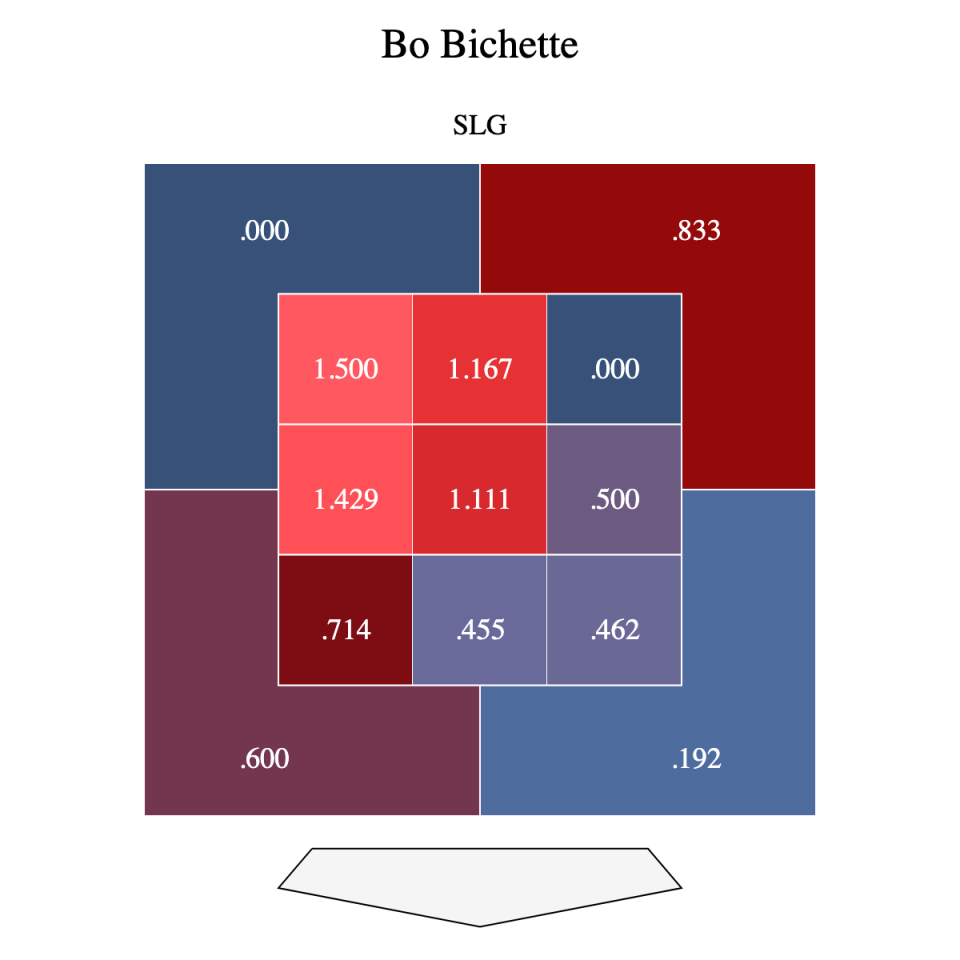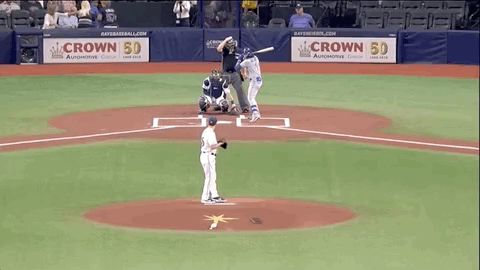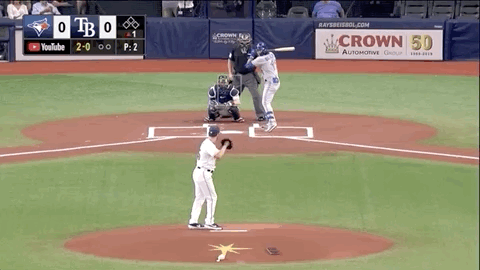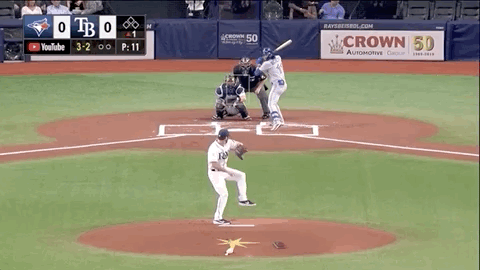Breaking down Bo Bichette's epic 13-pitch duel with Austin Pruitt

Bo Bichette’s introduction to the major leagues has been nothing short of remarkable, and its most impressive moment thus far came on Thursday night.
Bichette, an aggressive hitter not known for dragging out at-bats, engaged in a 13-round bout with Tampa Bay Rays starter Austin Pruitt to begin the game and emerged victorious — ending their battle with an opposite-field home run.
How did he win this marathon fight, though? To understand that, we need to understand two things: the matchup and the sequence.
The Matchup
Bo Bichette
The exact parameters of Bichette’s MLB offensive profile aren’t clear yet. He just hasn’t been in the majors long enough for that to be the case. What is obvious is that the 21-year-old can hit. He swings with conviction and the ball comes off his bat with authority.
Bichette entered the game with a .326/.362/.597 line overall with a slightly worse .299/.314/.557 against right-handers. He’s typically hammered fastballs (after Thursday’s game he’s slugging .754 against them) while he’s had the hardest time with breaking stuff (33.1 percent whiff rate).
In terms of hot and cold zones against righties, the shortstop has feasted on pitches middle-in:

Austin Pruitt
Pruitt doesn’t have spectacular stuff. His fastball comes in just below 92 mph on average and his success is predicated on keeping hitters off-balance with a four-pitch mix and avoiding walks. His fastball has been hit around this season, but both his slider and changeup have been effective in terms of both missing bats and inducing soft contact.
The 30-year-old brought reverse splits into the game as right-handers were letting loose on him to the tune of a .297.338/.527 line. That’s something that has been consistent throughout Pruitt’s career to this point as well, not a single-season fluke.
He has been hit extremely hard this year in the middle of the plate and outside by right-handers:

With all this information in mind, it’s clear Bichette had a distinct advantage. Pruitt’s strength against righties was pitching inside — which to be fair, was something of a rarity for him. If he tried to pitch to that strength, he’d be entering Bichette’s hot zone. If he went outside, where the rookie has been vulnerable at times, he was wading into waters that had been dangerous for him this year.
Pruitt could either pitch to his strength or Bichette’s weakness. Doing both simultaneously was not an option. The Rays starter chose the latter.
The Sequence
Pitch #1
0-0 Four-seam Fastball at 90.9 mph

Travis D’Arnaud set up on the low-outside corner hoping to freeze Bichette or induce some weak contact. Although pitching to the bottom third of the zone is no longer en vogue, a fastball perfectly painted into the lower-outside corner is awfully hard to hit.
This wasn’t that. Pruitt missed his first pitch by a sizeable margin and fell behind the leadoff man.
Pitch #2
1-0 Four-seam Fastball at 91.0 mph

Pruitt looked to rectify his first mistake on this pitch, but the right-hander only dug himself a bigger hole.
Given the veteran’s relatively modest heater, if he misses his spot by even a little bit he’s susceptible to get shellacked. In this case he missed by a lot, but the pitch bled into a place where it was unlikely to be hit.
On the other hand, it put him down 2-0 against a dangerous hitter.
Pitch #3
2-0 Four-seam Fastball at 91.2 mph

On the surface, it looks like D’Arnaud called for the same pitch and location for the third straight time. However, based on the point the backstop gives Pruitt, it seems that’s what he wanted. Through the duration of the at-bat the catcher sets up on the lower-outside corner every time, so the intended location of his pitcher’s offerings are not explicit.
This looks like a pitch Bichette should’ve had, and he undoubtedly wanted it, but Pruitt has an 81st percentile spin rate, so his four-seamer up in the zone is tougher than his raw velocity indicates.
Still, it was middle-up and the Blue Jays’ rookie is understandably disappointed not to get a hold of it.
Pitch #4
2-1 Slider at 86.8 mph

For the first time, D’Arnaud and Pruitt went away from the fastball here. It’s not a bad idea with Bichette likely thinking he’d see some more hard stuff in a 2-1 count. The only problem with the pitch was its execution.
The slider came in way too high to be effective and Bichette slashed it away to even the count. A good outcome for Pruitt on a bad pitch.
Pitch #5
Four-seam fastball at 91.8 mph

By this point in the at-bat, it’s pretty clear Pruitt was looking to stay away from Bichette’s power. He’s hoping to get this pitch close enough to the strike zone to elicit a swing or a generous call, but nowhere near the heart of the plate.
Ultimately, he accomplished his mission, but Bichette lent a hand by swinging on a pitch that wasn’t too close. The horizontal movement on Pruitt’s fastball is also well below league average (-5.9 inches) so it’s not like it has a deceptive glove-side break.
If you’re not a fan of watching a guy hit foul balls, this is a good time to turn back, because this is the “Bichette wasting pitches” section of this duel.
Pitch #6
Slider at 87.8 mph

This was a good pitch from Pruitt, perhaps the best in the at-bat.
Even so, Bichette was able to hang back and get a piece of the slider on the very edge of the zone. The rookie makes putting the bat to this ball look easy, but that’s far from the case.
Pitch #7
Four-seam fastball at 91.5 mph

This was another pitch Pruitt has to be happy with. The right-hander pounded the very top of the zone and kept the ball away from Bichette’s power.
An aggressive swinger like the 21-year-old isn’t going to get locked up on an offering like this, but it’s not impossible to imagine him whiffing on it.
He didn’t.
Pitch #8
Four-seam fastball at 91.7 mph

This is the type of pitch that’s effective situationally, but not in a vacuum. If Pruitt threw this 0-0 almost any hitter in the league would take it.
However, at 2-2, with Bichette in swing mode, it’s not a surprise the bat came off his shoulder. The count allows Pruitt to hammer the area just outside the zone and this pitch is a good example of how the pitcher is able to stay in command as long as the at-bat stays at 2-2 and throwing a ball doesn’t cost him anything.
Pitch #9
Four-seam fastball at 92.7 mph

Pruitt dialled his fastball up a notch here and Bichette was a little bit late. By this point, the right-hander was probably pretty damn sick of the rookie and willing to expend a little extra energy if it meant putting him to rest.
It’s a worthy gambit, but it didn’t work.
Pitch #10
Slider at 88.0 mph

This is where the complexion of the at-bat changes, although you wouldn’t know it from the next pitch Pruitts throws. Bichette’s ability to lay off this slider meant the Rays pitcher had to come to him.
Ultimately, that ended up making all the difference in the world.
Pitch #11
Slider at 88.7 mph

This was by far the weirdest moment of the at-bat. Pruitt pulled his slider a bit, finishing it further outside the zone than the count warrants. Bichette swung at a pitch he had no business swinging at.
It looked like a strikeout, but the shortstop got a piece, so each party was able to move on.
Pitch #12
Four-seam fastball at 92.3 mph

The penultimate pitch of this confrontation foreshadowed what was going to happen perfectly. Because of the three-ball count, and Pruitt’s reticence’s to concede a leadoff walk, he made the determination that he was going to return to the strike zone after a five-pitch journey outside of the magic box.
Pruitt was challenging Bichette. This time, it results in another foul ball. He wasn’t so lucky on the net pitch.
Pitch #13
Four-seam fastball at 92.4 mph
Pruitt threw the exact same pitch in the exact same spot, and Bichette didn’t let him get away with it. Although the rookie sensation has been better at turning on balls in the middle of the plate, this was his third opposite-field home run of the year.
He had battled away everything his veteran opponent had to offer until Pruitt’s only remaining recourse was “challenge with the zone fastballs and hope for the best.”
As far as strategies to beat Bichette go, usually that’s just not going to be good enough.
More Blue Jays coverage from Yahoo Sports



